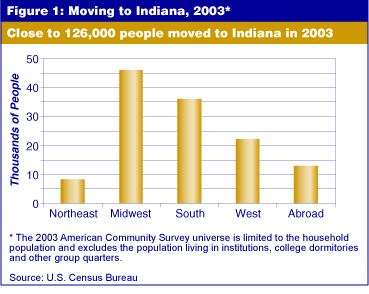People Do Move to Indiana
Indiana may have lost a seat in Congress due to a relative decline in population, but people do move to Indiana. At a recent dinner, I sat next to a gentleman who had moved to Indiana in June. I myself had moved here in July, so I thought, “Just how many people are moving to Indiana?” According to the latest American Community Survey (ACS) data from the U.S. Census Bureau, an estimated 125,735 people moved to Indiana in 2003 (see Figure 1). Most (36 percent) moved from elsewhere in the Midwest, while 29 percent moved from the South, 18 percent from the West, 10 percent from abroad, and 7 percent from the Northeast.

Update on the American Community Survey
The ACS is a relatively new program that is designed to give communities a “fresh look” at how they are changing. The intent is to have the ACS replace the long form in future decennial censuses. The Census Bureau had planned to begin full implementation of the ACS beginning in July 2004. However, the bureau has temporarily delayed the ramp-up due to current uncertainties in the congressional appropriations process for fiscal year 2005. Plans continue for conducting the full ACS for housing units in 2005 and for including data on group quarters in 2006.
The administration requested $165 million from Congress for the ACS, but the House approved only $146 million. Meanwhile, the Senate approved just $64 million, not even 40 percent of what was requested.
Because of these uncertainties, the Census Bureau has temporarily delayed the expansion to all U.S. counties and will continue the current program. For Indiana, this includes collecting data for Allen County, Fort Wayne, Indianapolis, Lake County, Marion County, South Bend, St. Joseph County, and U.S. Congressional District 7. The delay should have no impact on the ACS estimates for 2004.
New Policy Regarding Sensitive Data
On Aug. 30, the Census announced it would implement new procedures for dealing with potentially sensitive data. Special tabulations of data involving sensitive populations (including minority groups) that are requested by a federal, state or local law enforcement or intelligence agency will require approval by an associate director at the bureau. Previously, requests for special tabulations were reviewed only if the bureau was to be reimbursed for the work. The change responds to recent concerns about data provided to agencies within the Department of Homeland Security. The tabulations are legal and the data is publicly available on the Census’ website, but Director Louis Kincannon feels that the Bureau should be sensitive to public perceptions of threats to confidentiality or privacy.
Facts for Features: Thanksgiving Day, 2004
To celebrate Thanksgiving, the Census Bureau has released facts, figures and trivia about turkey, cranberries, pumpkins, corn, sweet potatoes and more. Did you know that:
- An estimated 263 million turkeys will be raised in the United States this year. About 46.5 million of them will be raised in Minnesota.
- Turkey, Texas, had 507 residents in 2003.
- There are 20 places in the United States named Plymouth. The most populous is Plymouth, Minnesota (69,164 residents in 2003). There is one township named Pilgrim. Located in Dade County, Missouri, it has a population of 135.
Frank Wilmot
State Data Center Coordinator, Indiana State Library
